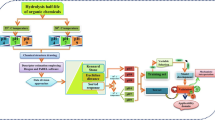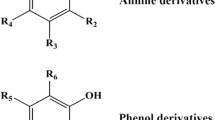Abstract
Rate constants of ozone with 39 aromatic compounds in aqueous solution were determined at 298 K. And optimized calculation was carried out at B3LYP/6-311G** level with DFT method. 10 molecular parameters obtained from calculations were selected as the descriptors to establish QSAR models for predicting the rate constants. These descriptors include structural, electronic and thermodynamic parameters. The optimum model was −logk′ = 4.656 + 0.015CMA-1.684E LUMO−3.057qH+, of which square regression coefficient R 2 = 0.791, standard deviation SD = 0.126. Stability of the model was checked by leave-one-out cross-validation and variation inflation factor. The QSAR model showed that the main contribution to degradation was the CMA parameter.


Similar content being viewed by others
References
Bali U, Catalkaya EC, Şengul F (2003) Photochemical degradation and mineralization of phenol: a comparative study. J Environ Sci Health A 38:2259–2275
Bertanza G, Collivignarelli C, Pedrazzani R (2001) The role of chemical oxidation in combined chemical–physical and biological processes: experiences of industrial wastewater treatment. Water Sci Technol 44:109–116
Catalkaya EC, Bali U, Sengul F (2003) Photochemical degradation and mineralization of 4-chlorophenol. Environ Sci Pollut Res Int 10:113–120
Denisova TG, Denisov ET (1998) Reactivity of ozone as a hydrogen-atom acceptor in reactions with antioxidants. Polym Degrad Stabil 60:345–350
Famini GR, Penski CA, Wilson LY (1992) Using theoretical descriptors in quantitative structure activity relationships: Some physicochemical properties. J Phys Org Chem 5:395–408
Fatemi MH (2006) Prediction of ozone tropospheric degradation rate constant of organic compounds by using artificial neural networks. Anal Chim Act 556:355–363
Frisch MJ, Trucks GW, Schlegel HB, Scuseria GE, Robb MA, Cheeseman JR, Zakrzewski VG, Montgomery JA, Stratmann RE, Burant JC, Dapprich S, Millam JM, Daniels AD, Kudin KN, Strain MC, Farkas O, Tomasi J, Barone V, Cossi M, Cammi R, Mennucci B, Pomelli C, Adamo C, Clifford S, Ochterski J, Petersson GA, Ayala PY, Cui Q, Morokuma K, Malick DK, Rabuck AD, Raghavachari K, Foresman JB, Cioslowski J, Ortiz JV, Baboul AG, Stefanov BB, Liu G, Liashenko A, Piskorz P, Komaromi I, Gomperts R, Martin RL, Fox DJ, Keith T, Al-Laham MA, Peng CY, Nanayakkara A, Challacombe M, Gill PMW, Johnson B, Chen W, Wong MW, Andres JL, Gonzalez C, Head-Gordon M, Replogle ES, Pople JA (1998) GAUSSIAN 98, revision A.9. Gaussian, Inc., Pittsburgh
Kušic′ H, Rasulev B, Leszczynska D (2009) Prediction of rate constants for radical degradation of aromatic pollutants in water matrix: a QSAR study. Chemosphere 75:1128–1134
Liu SS, Yin CS, Wang LS (2003) VSMP: a novel variable selection and modeling method based on the prediction. J Chem Inf Comput Sci 43:964–969
Ren YY, Liu HX, Yao XJ, Liu MC (2007) Prediction of ozone tropospheric degradation rate constants by projection pursuit regression. Anal Chim Acta 589:150–158
Sabljic A, Peijnenburg W (2001) Recommendations on modeling lifetime and degradability of organic compounds in air, soil and water systems. Pure Appl Chem 73:1331–1348
Suarez S, Dodd MC, Omil F (2007) Kinetics of triclosan oxidation by aqueous ozone and consequent loss of antibacterial activity: Relevance to municipal wastewater ozonation. Water Res 41:2481–2490
Turabekova MA, Rasulev BF, Levkovich MG, Abdullaev ND, Leszczynski J (2008) Aconitum and Delphinium sp. alkaloids as antagonist modulators of voltage-gated Na+ channels. AM1/DFT electronic structure investigations and QSAR studies. Comp Biol Chem 32:88–101
Acknowledgments
This research is supported by national significant science and technology projects of china (2008ZX05024-02-09).
Author information
Authors and Affiliations
Corresponding author
Rights and permissions
About this article
Cite this article
Jiang, J.L., Yue, X.A., Chen, Q.F. et al. Determination of Ozonization Reaction Rate Constants of Aromatic Pollutants and QSAR Study. Bull Environ Contam Toxicol 85, 568–572 (2010). https://doi.org/10.1007/s00128-010-0127-5
Received:
Accepted:
Published:
Issue Date:
DOI: https://doi.org/10.1007/s00128-010-0127-5




